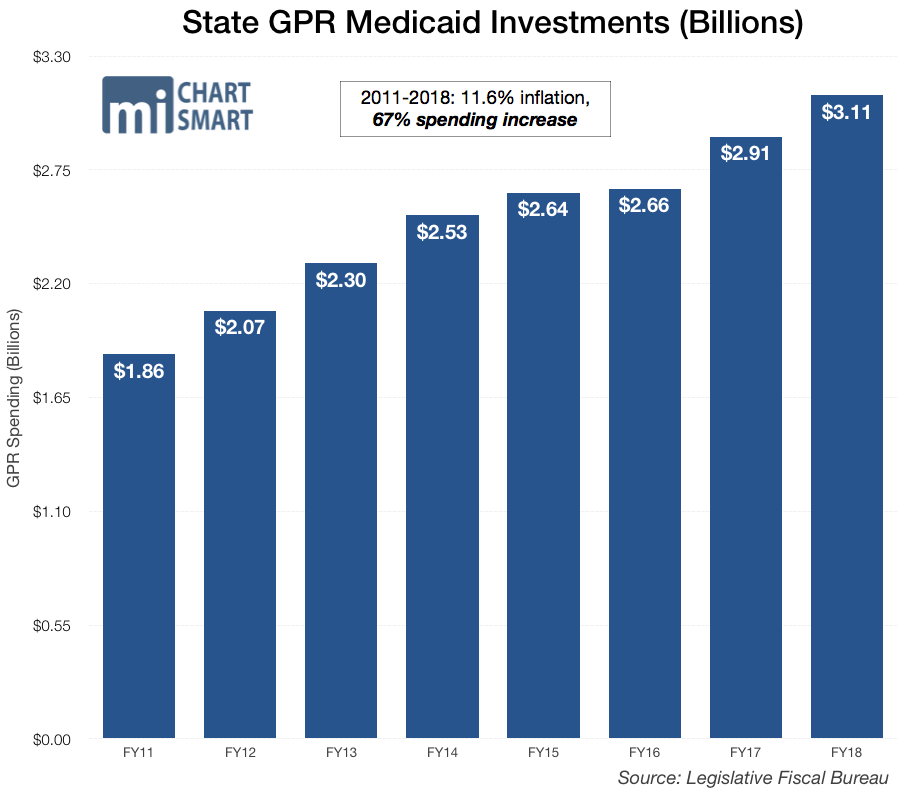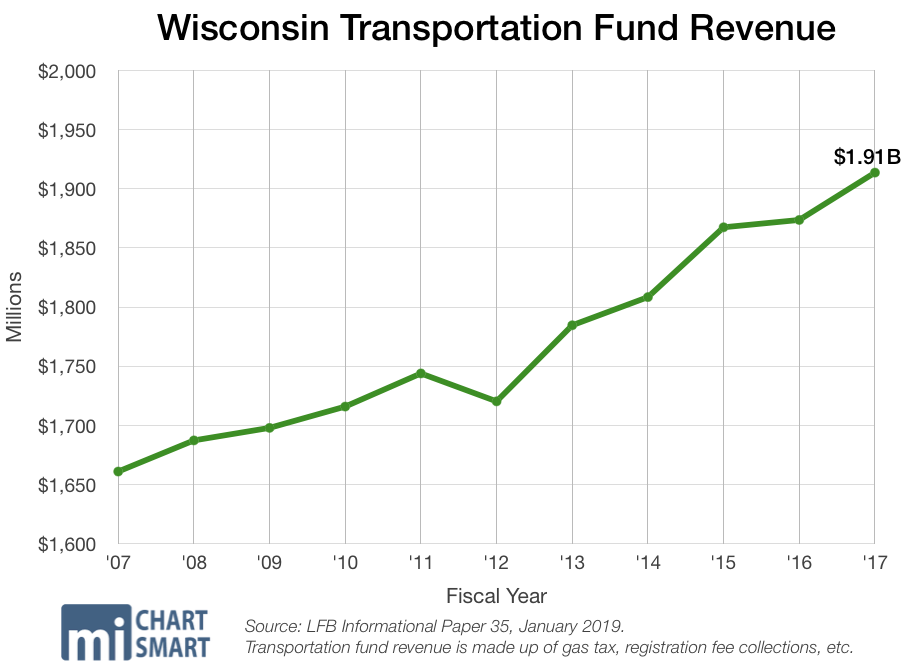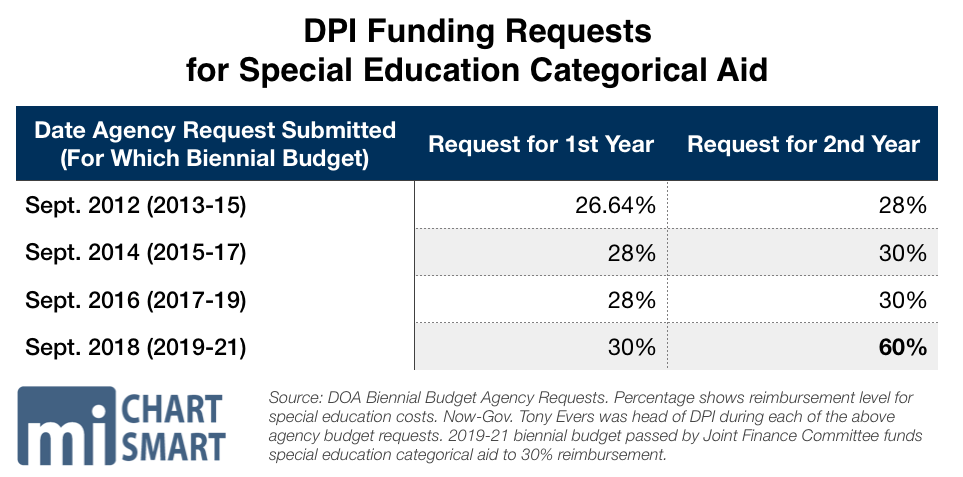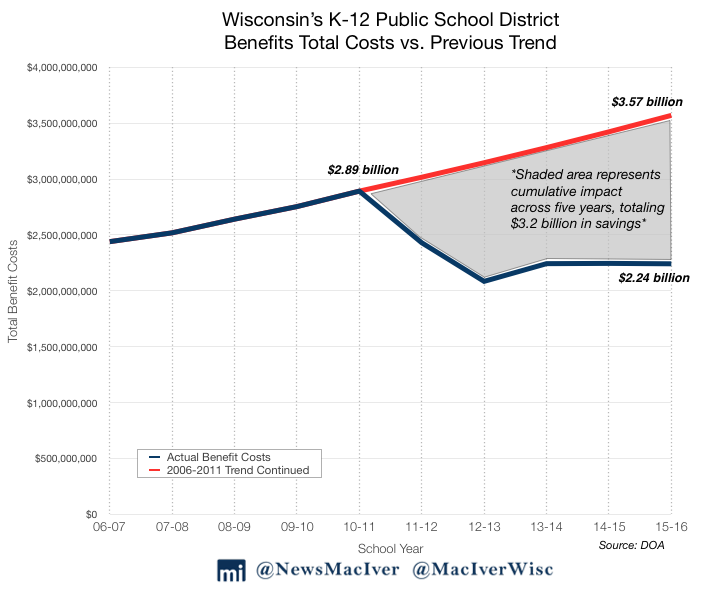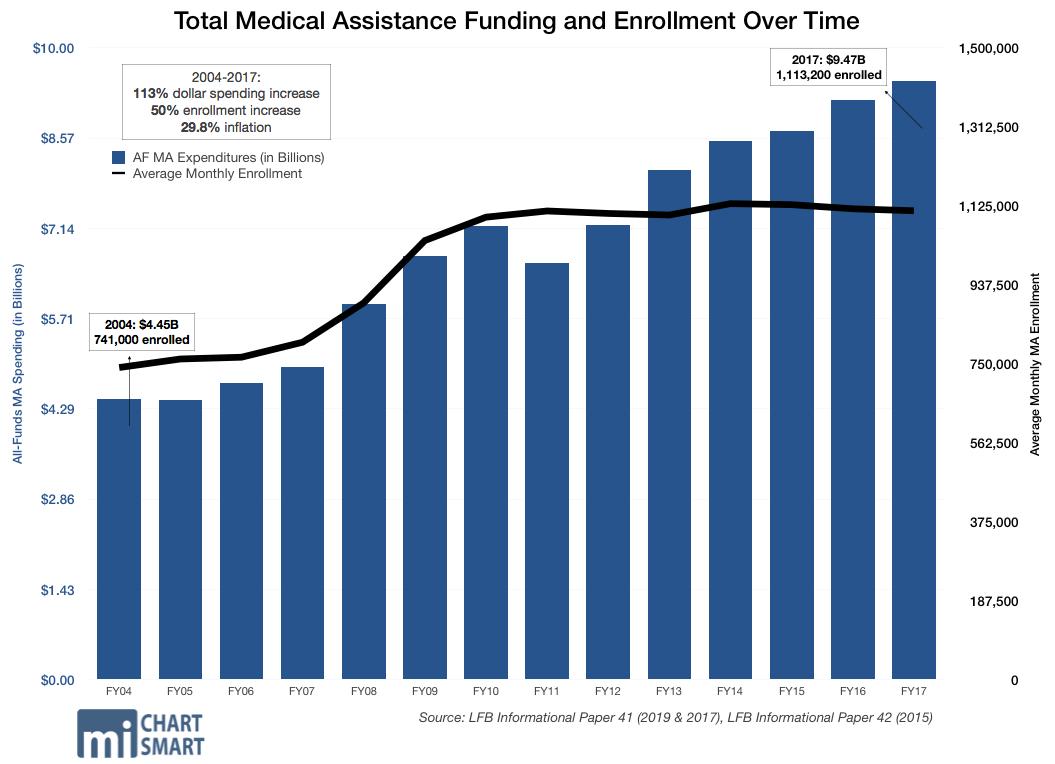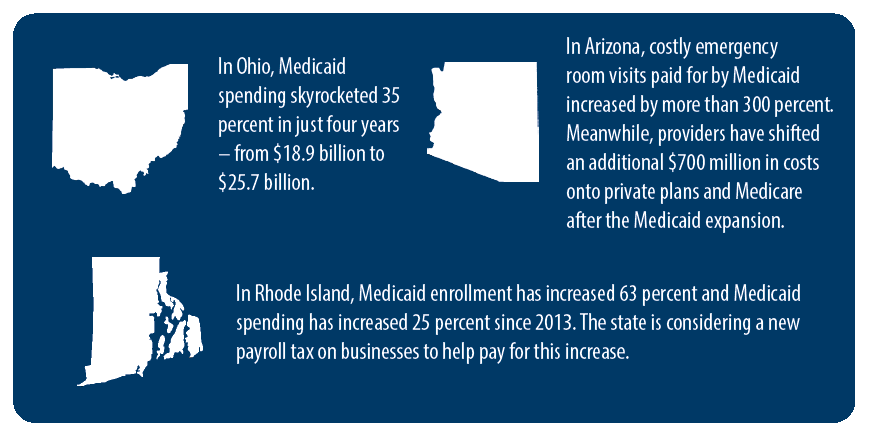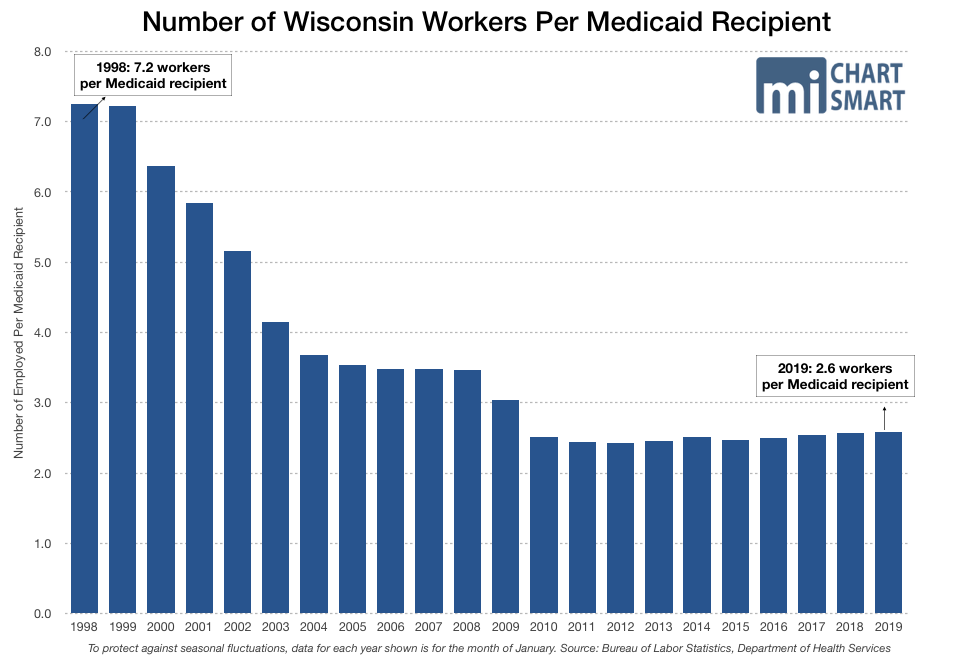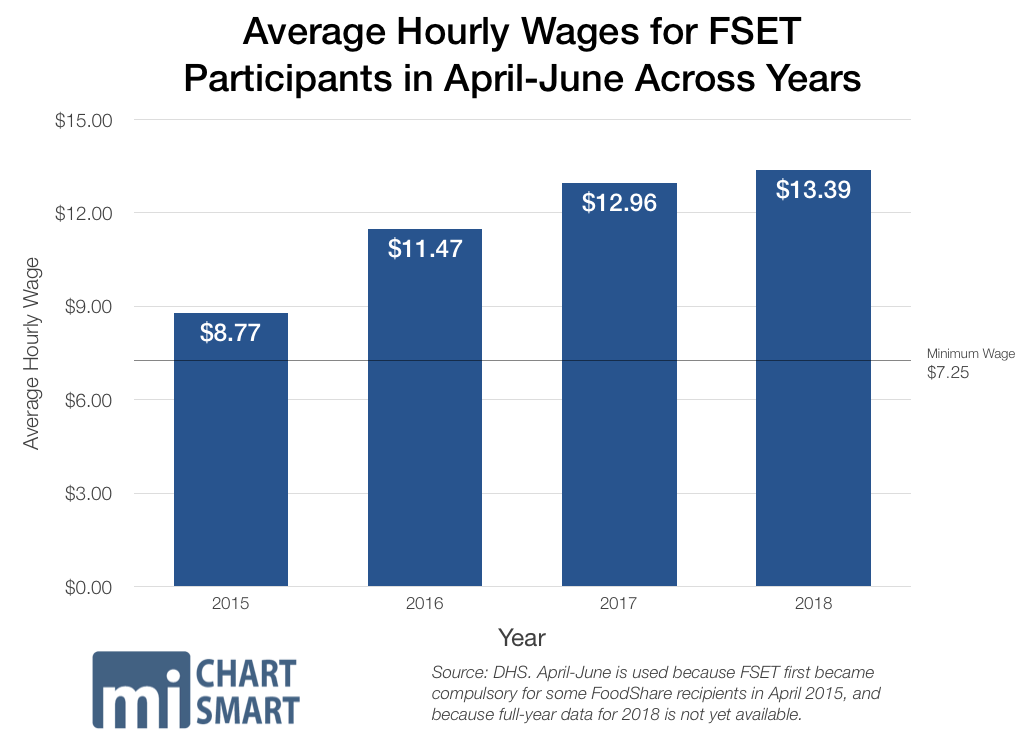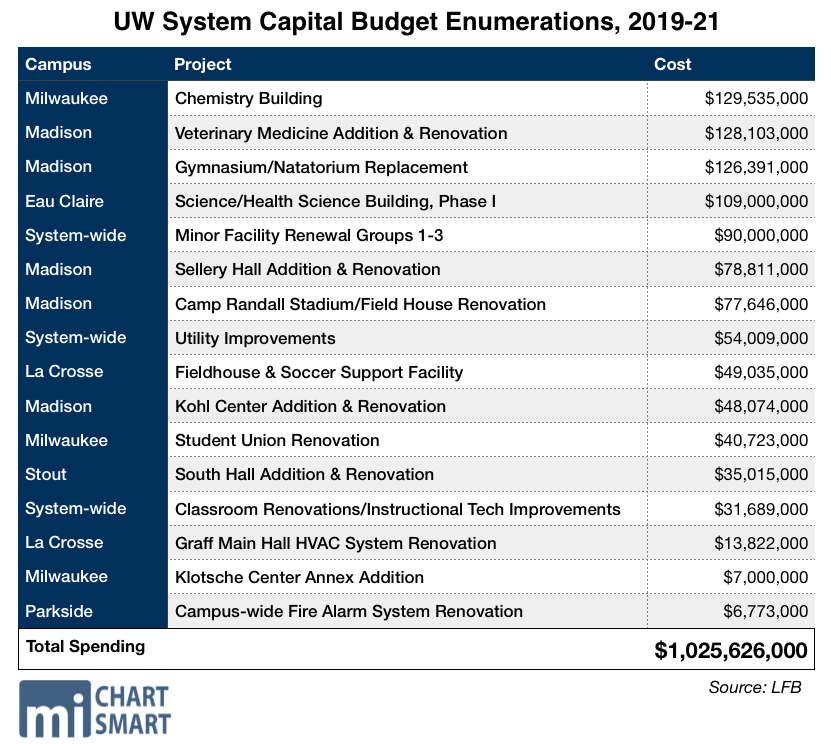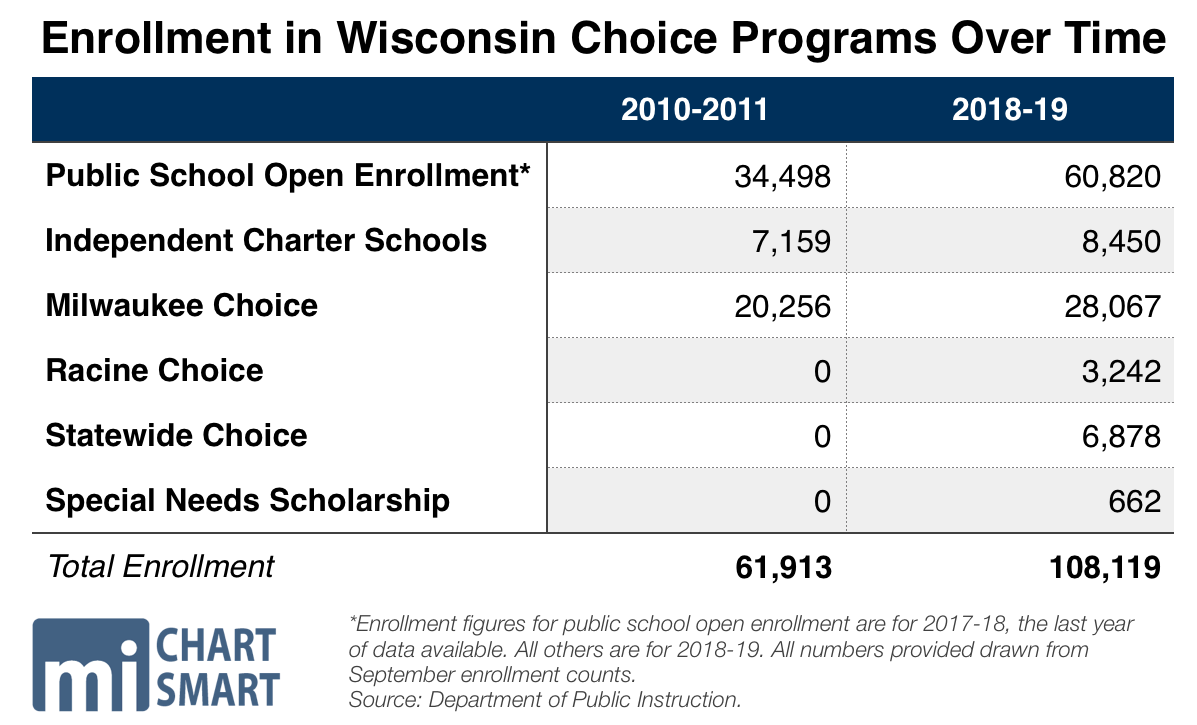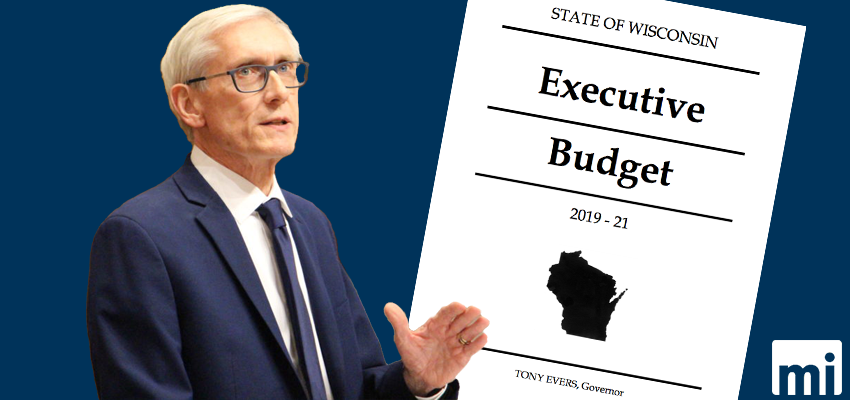 [bctt tweet=”Something for everyone to love and hate; No reforms, but disasters avoided; Tax cuts, but spending hikes. MacIver analyzes the 2019-21 state #wibudget; #wiright #wipolitics” username=”MacIverWisc”]
[bctt tweet=”Something for everyone to love and hate; No reforms, but disasters avoided; Tax cuts, but spending hikes. MacIver analyzes the 2019-21 state #wibudget; #wiright #wipolitics” username=”MacIverWisc”]
Disasters avoided, the reform(less) budget, unneeded spending increases all across the board, and the march to a flatter, fairer tax code
Something for everyone to hate in this budget, something for everyone to love in this budget
July 15, 2019
EXECUTIVE SUMMARY
The 2019-21 Wisconsin state budget is now law. After months of debate, numerous public hearings, countless hours making its way through committee, dozens of amendments voted on and almost 80 vetoes, Assembly Bill 56, the state budget bill, has been signed into law by Governor Tony Evers and is now 2019 Wisconsin Act 9.
There is something for everyone to love in this budget – from fiscal conservatives, far-left progressives, Republicans, taxpayers, Democrats, big-government loving special interests, lobbyists, to local governments – and something in this budget for everyone to hate.
That makes this budget different than any other budget in recent memory. It really should come as no surprise, however, given the fact that we have divided government with Democrat Tony Evers as governor and both houses of the Legislature comfortably controlled by Republicans.
Disasters Avoided – Big Labor, The Big Loser
To fully understand how we got to this place, you have to start at the beginning when Evers introduced his budget proposal in late February.
Evers’ budget proposal wasn’t just a big liberal wish list, but a radical progressive’s best dream.
Simply put, Evers introduced the most irresponsible and anti-taxpayer budget in recent memory.
Assembly Speaker Robin Vos (R-Rochester) described the Evers budget as a “big liberal wish list.” Looking at the expansive list of progressive policies that vastly grow the size and scope of government, it is hard to argue with that description.
From Medicaid expansion, the end of recent welfare work requirements, an unneeded increase in the state’s minimum wage, a green pipe dream to make the state carbon-free, the creation of many new government programs, an assault on proven education reform programs, the decriminalization of small amounts of marijuana, to the end of the property tax freeze — the budget wasn’t just a big liberal wish list, but a radical progressive’s best dream. As proposed, Evers’ budget would have also:
- Hiked the gas tax and tied it to inflation, for a total gas tax increase of nearly 10 cents per gallon
- Raised taxes on job-creating manufacturers by limiting the Manufacturing and Agriculture Tax Credit
- Raised taxes on retirees by ending a long-term capital gains tax exemption
- Repealed the state’s right-to-work law
- Restored the state and local prevailing wage
- Rolled back tax protections that have led to a property tax freeze, giving local units of government more power to raise property taxes
- Frozen enrollment in school choice programs
- Ended the Special Needs Scholarship Program
- Stopped new independent charter schools from opening until 2023
- Raised the minimum wage to $8.25 in 2020, followed by annual 75-cent increases until it reaches $10.50 in 2023, then tying it to inflation and creating a task force to study how to get to a $15 per hour minimum wage for everyone
- Raised the minimum wage for government workers to $15 per hour in 2021
- Spent $5 million to provide internet access for welfare recipients
- Eliminated work requirements for able-bodied adults with school-aged dependents
- Eliminated drug testing for most public assistance programs
- Created a new statutory goal for a minimum broadband speed across the state
- Tied revenue limits for school districts to inflation
- Deferred to agency rules and guidance documents, bypassing the Legislature and broadening the powers of the administrative state
- Created a $2 billion structural deficit while raising general fund taxes by $1.3 billion, and local property taxes by untold millions more
- And much, much more…
Thankfully, the Republican-led Joint Finance Committee (JFC) quickly removed all of these disasters. In its first executive session on the budget, it stripped out 131 policy items and more than $1 billion in tax increases. Almost every single big-government provision – except for gas tax indexing – was pulled out in JFC’s first budget action.
As we examine the final product today, it is important that we take time to remember how bad Evers’ original budget was and give Republicans credit for removing all of this bad public policy.
Medicaid expansion would have devastated health care affordability for the average Wisconsinite, pushing up premiums and severely limiting access to care. Low-income individuals who currently have subsidized, private plans for cents on the dollar would be forced onto a government plan with less access to providers and worse health outcomes. It would also push thousands more Wisconsinites onto a system that is already struggling to stay sustainable – just 2.6 Wisconsin workers support each Medicaid recipient today. In 1998, 7.2 workers supported each recipient. As it stands, Medicaid already has a serious math problem. Pushing enrollment even higher would only make health outcomes, access, and the program’s cost worse.

If you are still not sure if Medicaid expansion is a bad idea, just look at the states that have accepted it and what a financial hardship it has been for those states. Medicaid spending in Ohio, for example, skyrocketed 35 percent in four years – from $18.9 billion to $25.7 billion between fiscal year 2013 and 2017.
In Arizona, costly visits to the emergency room have jumped more than 300 percent and providers have shifted an additional $700 million in costs onto private plans after the Medicaid expansion. In Rhode Island, Medicaid enrollment ballooned 63 percent and state spending on the program has increased 25 percent since expansion, forcing the state to consider a new payroll tax on employers.

It also would expand welfare in a time of unprecedented economic growth. The final budget delivers substantial increases in health care and medical assistance funding without using money from a debt-ridden federal government that has failed to keep funding promises to states.
Those are among the many reasons why Republicans fought so hard to keep the idea out of the budget.

The same can be said of Republicans’ defense of worker freedom.
It’s no secret that Big Labor targeted Gov. Walker as public enemy number one and made removing him from office its number one priority in the entire country. No one should have been surprised when Evers’ first budget proposal handsomely rewarded his Big Labor allies with a full-out assault on worker freedom and the taxpayer.
Evers proposed bringing back Big Labor’s favorite trifecta: repealing right-to-work, reinstating the prevailing wage law, and forcing large public works construction projects to use project labor agreements.
Wisconsin’s previous prevailing wage statute, which arbitrarily and unnecessarily tied wages on taxpayer-funded construction projects to inflated rates paid by unions, was repealed for local and state projects by Gov. Walker. Without interference from the government, wages are set by the market and driven by competition, saving Wisconsin taxpayers millions of dollars. Remember the case of the Grafton water tower?

Evers’ budget also would have eliminated Wisconsin’s right-to-work law. It’s called right-to-work precisely because it prohibits private-sector labor organizations from making compulsory union dues a condition of employment. Wisconsin workers have shown, en masse, that they don’t want to join unions: active membership in the National Education Association fell by 42 percent from 2013 to 2018. The percent of Wisconsin workers who belong to a union fell from 15 percent in 2008 to 8.1 percent in 2018.
Simply put, if unions provided a service that members thought was worthy, such dramatic drop-offs would not have occurred. Clearly, workers are voting with their feet and they are voting that they do not need unions.
Evers’ budget would have reinstated project labor agreements (PLAs) for public works projects. Local governments, beholden to Big Labor, use PLAs to stipulate that only union firms can bid on a project, shutting out competition and dramatically increasing the cost of projects that taxpayers pay for.
Ultimately, much of what makes the 2019-21 budget a good document is marked by what’s not in it. That is thanks to Republicans and their willingness to stand up to Big Labor and the far left. That also makes Big Labor the unquestioned big loser of the 2019-2021 state budget debate.
Finally, we would be remiss to not mention one last issue left untouched in the 2019-21 budget: Act 10. Walker’s signature 2011 reform was repeatedly slammed by the now-governor on the campaign trail and in years past. Nowhere does the budget roll back taxpayer protections created by the law, including increased contribution levels for public sector employee benefits or annual union recertification votes. For the taxpayer, that is a major disaster averted.
A Fiscal Arms Race – Making Everyone But The Taxpayer Happy
There’s no way around it: this budget spends a lot of money. When Evers released his budget plan in late February, Republicans slammed the new governor for spending far more than the state could afford. Yet, in the end, Republicans backtracked on the fiscal austerity rhetoric and in many cases, ended up spending a lot more than what was necessary.
In what can only be called a great disappointment for taxpayers, legislative Republicans decided in many instances to spend more than they have in recent memory and in some cases, spend more than Evers’ original proposal.
Evers had proposed increasing total government jobs by 701 full-time positions over the biennium. That would have brought the total number of all-funds state positions to 71,990.57 in 2020. JFC’s plan increased total positions by 482, up to 71,771.59 by 2020. That’s still a sizable increase. Plus, this budget gives all state employees 2 percent raises in each year of the biennium, and by constantly adding to state rolls, those types of increases will only be more expensive in the future.
In what can only be called a great disappointment for taxpayers, legislative Republicans tried to keep up with the liberals when it came to government largess. In some cases, they even outdid Evers’ original spending proposals. Prison guards, personal care workers, nursing homes, and Family Care direct care workers get considerably more funding than Evers requested.

Taxpayers should also question the wisdom of pumping $655.4 million more GPR into the status quo educational system that fails too many children and is experiencing flat enrollment. In this biennium, state support to K-12 schools will reach more than $14 billion, and DPI’s total budget spends north of $15.2 billion. Evers had proposed a $1.6 billion increase for the agency he headed until January, including more than $600 million to increase special education categorical aids. The final budget sends $330 million more into the equalization aid formula and $97 million more for special education categorical aids, along with a litany of other changes.
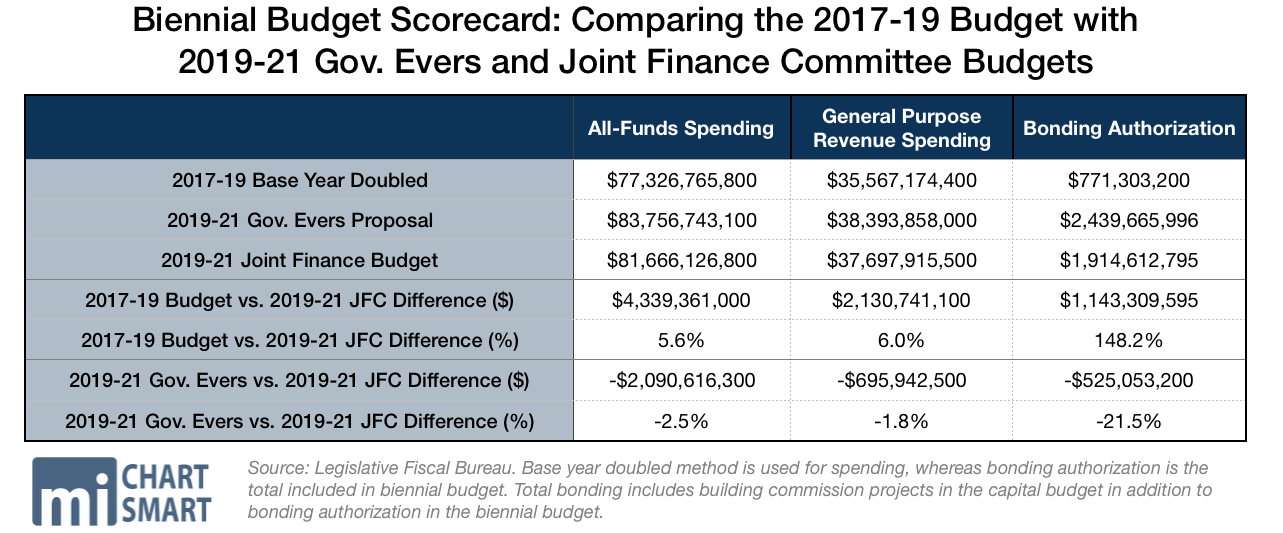
Still, JFC rejected the vast majority of Evers’ proposed changes to the school funding formula, such as adding another weight for impoverished students (counting them as 1.2 pupils instead of 1.0 for funding purposes). That led Evers’ supporters to slam the education plan, calling it a “$900 million cut.”

Only in Madison and the fantasy land of the nonsensical progressive is a $655 million increase in spending described as a cut.
Lost in this debate is the fact that Wisconsin’s K-12 population has stayed relatively flat for many years. If we are not experiencing a huge influx of new elementary kids to educate, why do our schools need $600 million in new funds? And this $600 million increase is on top of the $600 million increase included in the 2017-2019 state budget. Over a billion dollars in new funding to educate the same number of kids? Are we seeing any noticeable return on our increased investment?
Also lost in this debate is the fact that more and more families are choosing other educational choices outside of the public education system. Choice, charter and home schooling are all growing in popularity. That’s no surprise given that statewide English proficiency sits at just 44 percent, and math proficiency at 41 percent.
The K-12 educational system has continually failed many Wisconsin students, with thousands of new UW freshmen requiring remedial math or English. Those classes come with zero credit and the cost of full tuition, putting students behind before they even begin. Plus, many of these are students who were told they were doing well in school. More than half of Wisconsin’s five-star high schools sent more than 1,000 students who needed math remediation to UW.

And when just 54 percent of our public education dollars reach the classroom, we must ask how hundreds of millions of dollars will improve student achievement? For their part, legislative Republicans acknowledged the system is broken. But they didn’t take the opportunity to couple a significant funding increase with required better outcomes and meaningful systematic reform.
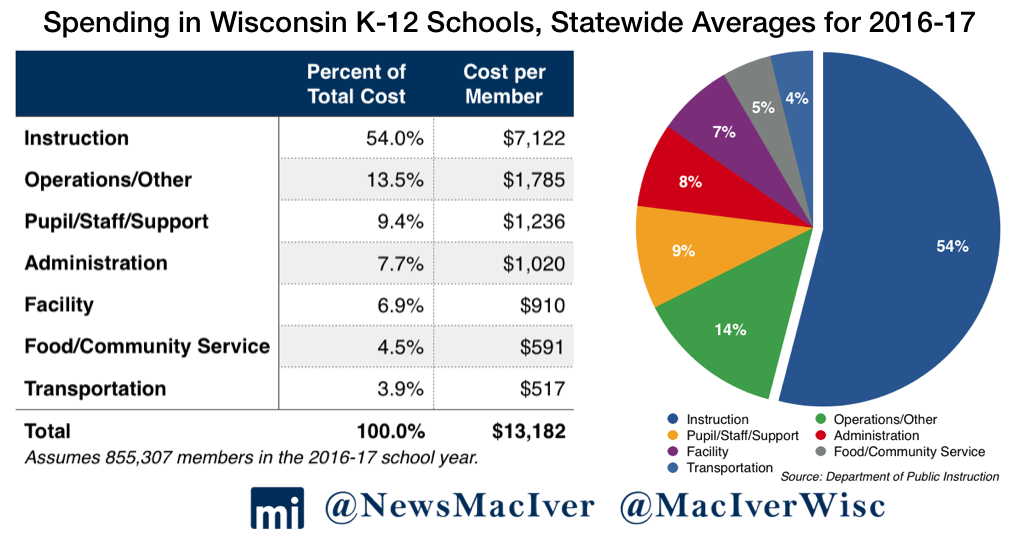
The same can be said for the UW System and the $220 million more it received compared to the last budget. Like the K-12 system, enrollment at UW has slowly fallen over the years. With a strong economy and record-low unemployment, young people now know that the math has changed. It’s no longer a given that taking on tens of thousands of dollars in student debt will pay off in the long run, and enrollment trends reflect that.
Still, the capital budget sends over $1 billion in new funding for building projects across the UW System. Numerous campuses, like UW-Eau Claire and UW-Milwaukee, will get brand new buildings, and every campus will see millions more in improvement projects.

Before the JFC vote on the capital budget, finance Co-Chair John Nygren (R-Marinette) spoke passionately on how broken the system is. He lamented that taxpayers pay UW lobbyists that then lobby the state for more money. He also lambasted the fact that UW officials are the drivers of new projects, setting rates and budgets for new buildings, knowing that the Legislature usually just goes along with the plan.
Nygren is exactly right on this – but he and every other JFC Republican voted for the package. It’s refreshing to see legislators make strong arguments at the table. But it’d be more refreshing if they would actually pass the reforms they say they want.
The health care debate brought a similar tone. Republicans held strong in refusing to expand Medicaid, but they instead agreed to send $1.6 billion in all funds to DHS. Of that increase, $917 million (all funds) is the cost-to-continue price tag for the state’s massive Medical Assistance programs.
Rather than pursuing innovative reforms in taxpayer-provided health care programs like direct primary care, self-funded association health plans, limited duration health plans, and dental therapy, JFC pumped more money into the Medicaid system they acknowledge is broken.
Too many politicians are content just throwing more money at these programs and these problems without addressing the fundamental causes of these problems and without making needed reforms to these programs.
Like so many other parts of the state budget, the new, incredibly generous funding for DHS came with little-to-no reforms attached. For taxpayers, this is frustrating and a huge missed opportunity to make Wisconsin a better place to live. Too many politicians are content just throwing more money at these programs without addressing the fundamental causes of the problems and without making needed reforms to these programs.
The Reform(less) Budget
As we’ve written above, on issues from K-12 education, Medicaid, higher education, welfare reform to the capital budget, legislators enacted few reforms to go along with the billions more in new spending they provided. One possible reason for this missed opportunity: Evers has the most powerful line item veto in the country. The majority of the few reforms contained in this budget were predictably vetoed out by the governor.
Nevertheless, it’s crucial that both sides fight for their beliefs and make their positions known. Taxpayers deserve an honest and genuine debate about the direction of our great state. If the capital building program is clearly broken, what’s the harm in proposing a groundbreaking new strategy to fix it? Debating an idea in public is always better than agreeing to compromise behind closed doors.
Why didn’t we have a debate about the needed reform of MPS? Why didn’t we have a debate about the remedial education crisis and the fact that hundreds of Wisconsin high schools send thousands of students to the UW system unprepared to pass basic English and math tests? Why didn’t we have a debate about the need to empower parents to choose a school that’s right for their children?
Why didn’t we have a debate about the size, scope, and cost of state government?
Apparently The Only Area That Needs Reform – Transportation
Republicans deserve kudos for including one important transportation reform in their Department of Transportation (DOT) omnibus motion: a pilot program for design-build projects. Rather than hiring a construction company after a road is designed, this active building method would bring in the construction company during the design phase. The theory is that the company can apply its practical experience to find efficiencies and cost savings that DOT engineers might otherwise miss. Evers used his veto pen to take out the part about it being a pilot program, meaning it is now officially in the DOT’s tool box.
Still, many fiscal hawks wanted more accountability for the troubled agency, giving rise to a separate transportation reform package that moved through the Legislative process in order to secure enough Republican votes in the Senate.
Earlier today, an Assembly committee held a lengthy hearing on a package of DOT reform bills. @RepSanfelippo explained that yes, there are pressing needs, but that makes reforming the department all the more important. #wibudget #wiright #wipolitics pic.twitter.com/sBFtQWGW7b
— MacIver News Service (@NewsMacIver) June 12, 2019
One reform bill proposed outside of the budget expands the number of road plans “on the shelf” so that the project pipeline can be managed more efficiently.
Another piece of legislation in the transportation reform package targets a practice that has cost taxpayers a lot of money — single-bid contracts. The bill would require the DOT to rebid projects that receive but one bid if that bid exceeds the department’s estimated cost of work by 10 percent or more. A fallback provision would allow the DOT to avoid the requirement in cases of a threat to public safety, if JFC approves.
As MacIver News Service recently reported, the state has awarded 58 single-bid contracts worth $309 million since January. DOT Secretary-Designee Craig Thompson, who spent years working on behalf of road builders and other transportation interests, now heads a state agency that refuses to release the original cost estimates, even after the contracts are awarded.
As MacIver News Service recently reported, the state has awarded 58 single-bid contracts worth $309 million since January.
The state highway program audit in 2017 found that one-bid contracts cost the state an average of $4.5 million a year from 2006 to 2015.
The most controversial reform bill would require local governments considering implementing vehicle registration fees — or wheel taxes — to first get approval from voters through referendum. More controversially, the measure demands communities with existing wheel taxes to take the question to voters within 18 months of proposing a fee increase.
Another reform measure before the Legislature would create a Subgrade Efficiency Provision in state law, allowing contractors to use DOT-approved alternative, lower-cost materials for the under layer of road projects. The change could lead to big cost savings for the contractor and, ultimately, the taxpayer.
A related reform would require the DOT to use project materials for sources on the DOT right-of-way, rather than paying higher costs to source and transport materials from more distant locations.
While that package moved through the Legislature as its own set of bills, the Assembly also amended the budget bill on the floor in order to ensure its passage in the Senate. That amendment did away with a JFC transportation provision that would have given the committee the authority to approve the implementation of a mileage-based fee. Instead, any recommendations from a study committee would have to be included in the Department of Transportation funding request for the next budget.
Critics worried that a decision on tolling recommendations and the controversial mileage fee would ultimately be in the hands of one committee, not the full Legislature. That became a moot point, as Evers vetoed the tolling and mileage studies out of the final budget.
Implementing these reforms in the DOT became even more urgent with the passing of the state budget. The DOT received a $600 million funding boost in the new state budget, which included the enumeration of two new major projects.
A Tax Cut To Bring Fiscal Conservatives Home – Continuing The March Towards A Flatter, More Equitable Tax Structure In Wisconsin
Wisconsin has long had one of the country’s most regressive individual income tax systems. The bottom tax rate of 4 percent is among the very highest in the country for low earners. Walker made progress in flattening the tax rate to benefit every single Wisconsinite, but the lowest rates have remained particularly punitive.
The budget act, along with a separate bill championed by Sen. Dale Kooyenga (R-Brookfield) and Rep. Jessie Rodriguez (R-Oak Brook), lowers the bottom two individual income tax rates. In 2019, the bottom rate (currently 4 percent) will drop to 3.89 percent. The second rate of 5.84 percent will shift downward to 5.08 percent. In 2020, both rates will fall even further, with the lowest rate moving to 3.76 percent and the second rate to 4.93 percent.

Between both sets of changes, the average income tax decrease will be $91 in 2019 and another $124 in 2020, totaling $215 in income tax relief over the biennium for the average filer.
These changes will benefit every single taxpayer in the state, and reducing the bottom two tax brackets will help middle-class earners the most. The bulk of the tax relief, in dollars, will go toward those earning between $30,000 and $60,000 annually.
MacIver has long argued that a flat tax system is the most equitable and fairest method of taxation. While we’d prefer a flat 3 percent rate across the board, any flattening of tax rates is a substantial win that should be celebrated.
Plus, Republicans achieved those tax cuts of over $500 million without raising taxes on other people. Evers’ proposed tax cuts were not true tax cuts at all, but instead they were tax shifts. His plan would have limited the Manufacturing and Agriculture Tax Credit (MAC). That move would punish job creators driving the growth in Wisconsin’s economy. Evers would have also stripped back long-term capital gains exclusions, a change that would punish retirees and rob their nest eggs.
Not only was Evers’ plan based upon a punitive tax shift, but his middle income tax cut would not have changed the actual income tax rates, which are the heart of the issue. His plan would have given middle class earners 10 percent of their net tax liability back, or $100, whichever is greater. Buying down the income tax rates rather than tinkering with credits is a much more effective, direct way to fix Wisconsin’s income tax structure.
The Long Road Ahead
JFC’s budget leaves a $1.4 billion structural deficit for the beginning of the 2021-23 budget cycle. That’s less than Evers’ almost-$2 billion deficit, but it’s still a massive figure. Walker took heat for leaving structural deficits in his budgets, but taxpayers could rest assured that the former governor would never raise taxes to fill a budget hole.
We hope legislators remember the hard-working taxpayer who foots the bill in the years to come when these tough decisions will need to be made.
Now? They shouldn’t be so sure. Evers’ original budget proposal would have raised taxes by close to $2 billion when considering the general fund and locals’ abilities to raise property tax levies. Our governor is clearly an eager tax-and-spend liberal, who will want to increase taxes to solve any structural deficit or budget hole. Will legislative Republicans be strong enough to just say NO to new taxes if the economy turns south?
The state went into this budget cycle with a $753 million surplus, higher than expected following months of strong economic growth. Yet the Legislature spent all that, and more, on various programs, leaving the state with a $1.4 billion structural gamble, with taxpayers on the hook.
All it would take is a single bad year for the economy, an escalation of the trade war, or any number of other crises for any future surpluses to quickly turn into deficits.
And two years from now, we’ll be back in the same position, with stakeholders from every corner of the state coming to the Legislature with hats and hands out, asking for more money. As we know, it’ll never be enough.
We will need to do better next time.
FULL ANALYSIS: K-12 EDUCATION
As former state Superintendent of the Department of Public Instruction (DPI), Gov. Tony Evers made K-12 education a top priority in his 2019-21 biennial budget proposal. That is, as long as students attend the types of schools he prefers.
Evers’ massive spending proposal called for nearly $1.6 billion more for DPI over the biennium, another record hike over the prior budget’s increase of more than $630 million. It would have dramatically reworked the school funding formula, based on a proposal long-championed by Evers called “Fair Funding for Our Future.” It also drastically restricted access to educational choice.
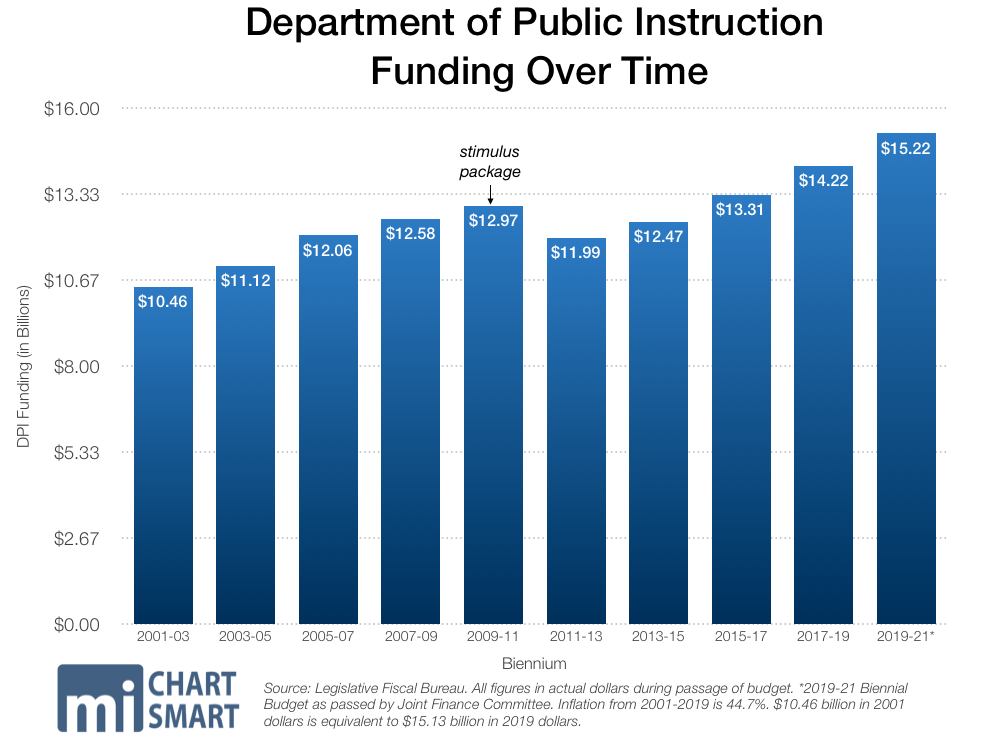
JFC pulled back on Evers’ proposal, opting to spend $655.4 million more in GPR for DPI. The finance committee pulled out every limitation on school choice that Evers had proposed, leaving the programs untouched. The committee also removed the majority of his proposed changes to the school funding formula.
In the end, Evers’ veto pen increased DPI’s overall spending to a more than $700 million hike over the biennium. The state aid spending increase to DPI is the largest across all agencies.
With the veto pen, districts will receive larger per pupil aid payments for each student – up from $654 this year to $742 in each of the next two years. That totals nearly $90 million more in overall state spending. Evers also vetoed out an $18 million program that provides free laptops for all high school freshmen.

The extra money comes with zero reforms, and for a broken education system with flat enrollment. In this biennium, state support to K-12 schools will reach more than $14 billion in the biennium, and DPI’s total budget spends north of $15.2 billion. Evers’ original proposal included more than $600 million to increase special education categorical aids. JFC sent $330 million more into the equalization aid formula, $97 million more for special education categorical aids, along with a litany of other changes.
Still, the finance committee rejected the vast majority of Evers’ proposed changes to the school funding formula, such as a weight for impoverished students (counting them as 1.2 pupils instead of 1.0 for funding purposes). That led Evers’ supporters to slam the education plan, calling it a “$900 million cut.” Of course, only in Madison is a $655 million increase described as a cut.
School districts affected by low revenue limits will be able to raise local property taxes to levy $9,700 per student in 2019, and $10,000 per student in 2020. Assembly Republicans fought for those changes in the last budget, though they were ultimately vetoed by Walker, who cited property tax concerns.
Lost in this debate is the fact that student enrollment has slowly declined over the years as families opt for other educational choices outside of the public education system. In the current school year, more than 853,000 children attend Wisconsin public schools, a figure that has fallen for years. At the same time, K-12 investments have increased. The state continues to spend more money to educate fewer children.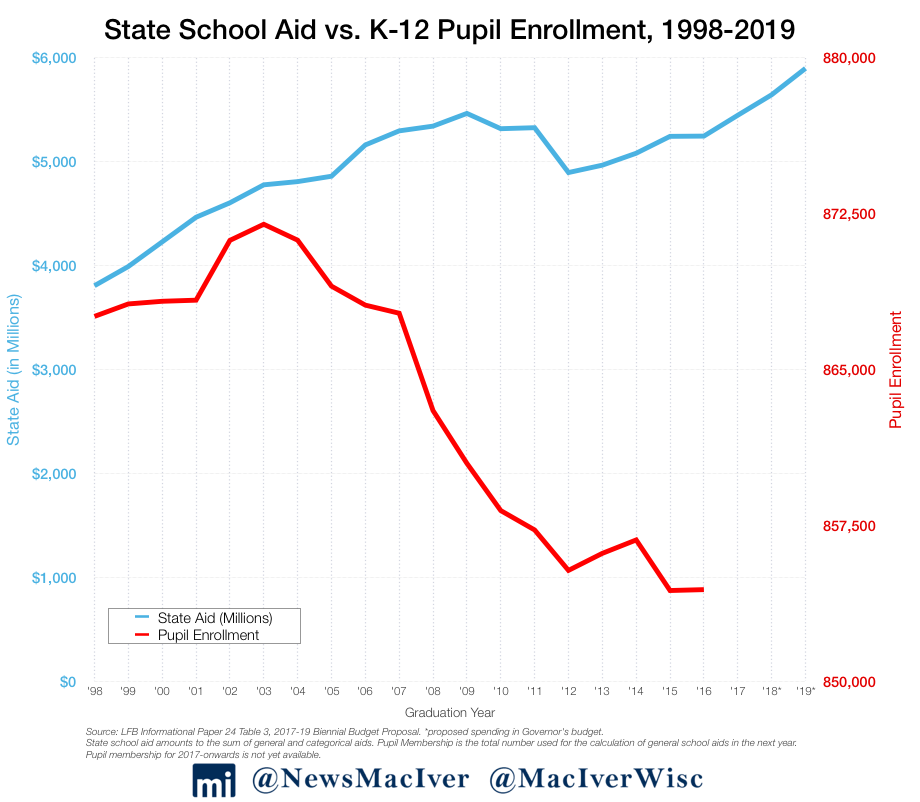
Prior to Act 10, benefits costs to districts had been increasing by 4.3 percent annually. Had that trend continued, taxpayers would be paying almost 60 percent more today.
And for all the claims Evers has made on what he believes to be the harmful effects of Walker’s Act 10, his budget does nothing to strip back those reforms. School districts have saved at least $3.2 billion on benefits plans since 2011 thanks to their newfound flexibilities. Even so, the majority of the taxpayer-funded plans are still incredibly generous, especially compared to the private sector.
Those savings are still reverberating. In March, Kenosha School District saved nearly $30 million on health care plans alone by switching providers. The district’s taxpayers will spend 41 percent less than their projections, and individual teachers will come out contributing even less toward their monthly premiums.
At 26 percent of districts, employees pay less than 12 percent toward monthly premiums on single plans. Years after Act 10’s requirement that public sector employees contribute at least 12 percent toward health care costs, just 74 percent of school districts comply with the rule for premiums. Prior to Act 10, benefits costs to districts had been increasing by 4.3 percent annually. Had that trend continued, taxpayers would be paying almost 60 percent more today.
That money adds up. In many cases, districts freed up dollars to go to the classroom by adjusting their benefits plans, Wauwatosa School District and MPS among them.
None of those savings are accounted for in state figures that show how much Walker put toward education. It is billions of dollars, previously locked down, that districts can now spend on their own priorities. Walker’s public sector collective bargaining reform legislation bent the cost curve for school and ultimately, for taxpayers. While spending on health care has exploded across the country, Wisconsin bucked the trend because of Act 10.
Why does this matter? Simply put, if school districts saved $3.2 billion on health care and retirement benefits, that money should have been directed to other education programs.
Finally, DPI’s own figures show just how little districts spend on those priorities. State figures show just 54 percent of district spending goes toward instruction. Just a slim majority of all K-12 education spending reaches the classroom.
If top-heavy overhead were reduced, the teachers doing the vast majority of meaningful work in schools could perhaps be better compensated. Instead, the many secondary and tertiary roles schools have taken on directly compete with the primary reason for schools’ existence: educating children.
FULL ANALYSIS: TRANSPORTATION
The long fight to raise Wisconsin’s gas tax was the jumping off point for the state budget’s transportation funding debate. It’s no secret that the road building lobby has been pushing for a gas tax hike for years, and given that Gov. Evers picked former road lobbyist Craig Thompson to lead the Department of Transportation, it’s not surprising that the governor included a gas tax hike in his budget proposal. That alone would have raised $484.9 million over the biennium, but Evers didn’t stop there. He also wanted to “index” the gas tax, which means it would automatically go up every year without the legislature ever voting on it again. That second increase would have raised another $41 million in the second year of the budget. Evers also included some fee increases that brought the grand total for new transportation revenue to $608 million.
Many in the Republican-led legislature have also been pushing for a gas tax hike for a long time, but Evers’ plan seemed like too much even for them. Instead the legislature chose to boost transportation revenue by $395 million solely through fee increases. Starting in October, title fees will go up $95, light and medium truck registration will go up $100, and annual automobile registration will increase $10.
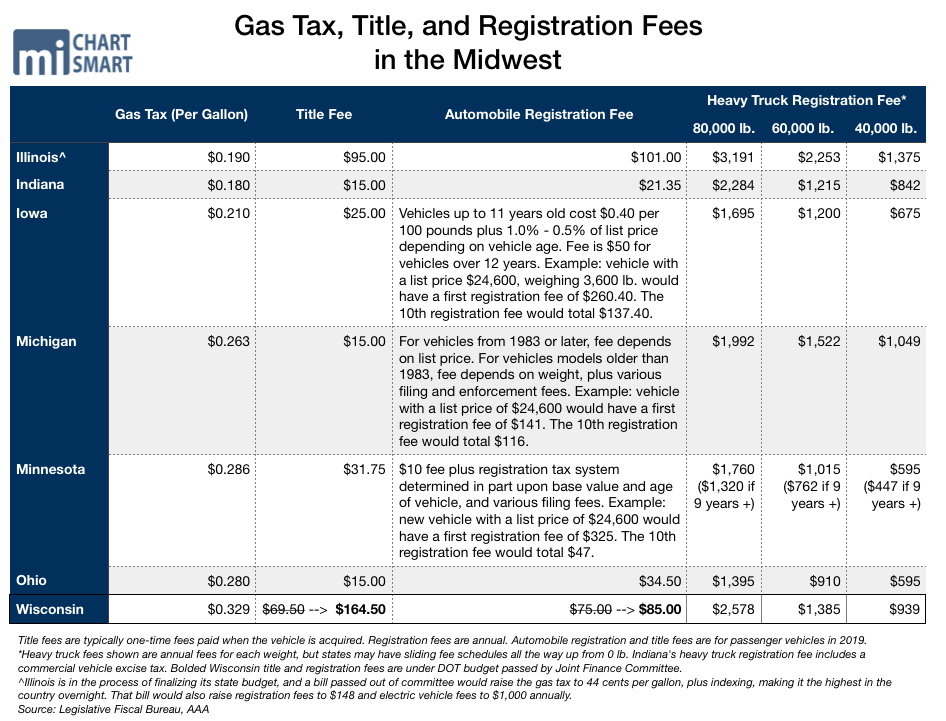
This brings the Department of Transportation’s total budget up to $6.6 billion for this biennium. That includes $326.3 million in new bonding (down from $401.4 million in the last budget.) Lawmakers praised this as the lowest level of transportation bonding in nearly 20 years. Unfortunately, overall bonding in this budget is at $1.9 billion, an all-time high.
From that, the State Highway Rehabilitation Program will get $3.3 billion, a $320 million increase from last budget. The Zoo Interchange will be completed under this budget. It also enumerates two new projects: the I-41 expansion, and the I-43 expansion in Milwaukee and Ozaukee Counties. The budget also provides funding for the WI-15 (Hortonville) bypass, which has been discussed for 20 years.
Local governments will get some more help from state taxpayers to run their local transportation programs. That includes an increase to General Transportation Aids (GTA) of $66.2 million. That comes out to a 10 percent increase, an all-time high. The Local Road Improvement Fund (LRIP) increased by $90 million.
There’s also $5 million in Supplemental transportation aids specifically for towns. That section also eliminated the requirement for towns to pay for at least 15 percent of their own transportation costs. They now have to pay nothing towards their transportation expenses, and spend only state aid if they so choose.
The legislature’s budget also included “discretionary supplemental grants” for additional road improvements for $90 million. Gov. Evers vetoed that down to $75,000, and then directed the DOT to hang on to it instead of sending it to local governments.
He explained in his veto message, “I am also requesting the Department of Administration secretary not to allot these funds. While additional investment in our local transportation needs is welcome, this provision creates yet another one-time subsidy to the transportation fund and illustrates the missed opportunity to provide a sustainable funding solution that would allow this program to be an ongoing investment in local communities without using the general fund to pay for transportation projects.”
Before the veto, that discretionary supplemental aid would have meant another $32 million for counties, $35.1 million for towns, and $22.8 million for municipalities.
Gov. Evers also used his veto pen to adjust two reforms in the legislature’s budget. First, he took out a preemption for local quarry zoning ordinances. That issue drives up the cost of material for state road projects when local governments try to block quarrying operations near the construction sites. Evers recognized the complexity of the issue, which is caught between local control and state fiscal responsibility. He says there should be more public debate.
He also made an interesting change to design-build. The legislature included it in the budget as a pilot program with a lot of strings attached. Evers vetoed out the part about it being just a “pilot program” and immediately put it into effect without the strings attached.
Looking past road funding, the budget also provides a $45.2 million boost to the Harbor Assistance Program, of which $29 million is expected to benefit Mercury Marine specifically. Also, $35 million is budgeted to Amtrak’s Hiawatha Line for rail projects.
FULL ANALYSIS: HEALTH CARE
When he signed the final 2019-21 budget, Gov. Evers traded in some of his key campaign pledges — Medicaid expansion at the top of the list — for a boatload of new money offered up by the GOP. While expanding Medicaid was unquestionably off the table from day one, a sizable share of the new spending in the Republican budget went to the state’s behemoth Medical Assistance (MA) program just to keep up with the cost of current enrollment.
The final budget sends $1.6 billion in additional all-funds dollars to the Department of Health Services (DHS), $187.5 million less than what Evers had proposed. From state GPR coffers, that’s a $588 million increase for DHS. In total, the DHS budget rises to $26.2 billion all-funds over the biennium, a 6.7 percent increase; $8.6 billion of that comes from GPR, a 7.1 percent increase.
Simply continuing to fund MA is a sizable part of that increase, with an all-funds price tag of $917 million just in cost-to-continue funding. MA consists mainly of the massive Medicaid program. Out of that massive sum, $356.1 million comes from previous state GPR dollars to continue Medicaid as-is.
But because the Evers budget relied so heavily on a $325 million influx of “free” federal cash, the final budget’s $588 million in new GPR spending is only $27.3 million less than what Evers proposed. The final JFC budget adds 166.3 new full-time equivalent positions at DHS, 25.74 fewer than Evers wanted.
Spending arms race
The Republican budget, now signed into law as 2019 Wisconsin Act 9, spends $60 million more GPR on disproportionate share (DSH) payments to health care providers that treat an unusually high number of Medicaid patients, an effort to make up for the program’s abysmal reimbursement rates to doctors and hospitals. With one of his 78 vetoes, Evers raised the cap on how much each hospital can receive under this payment by $400,000.
Final funding figures for nursing homes and direct caregivers, like home health care workers, were the result of the spending arms race between Republicans and Evers. Evers’ budget proposal called for $8.7 million in fiscal year 2020 and $17.8 million the following year, amounting to a combined 2.5 percent increase in fee-for-service Medicaid reimbursement for nursing homes. Critics challenged Evers’ claim that he was providing an historic boost in funding.
GOP lawmakers responded by upping the spending ante significantly on three home and personal care related programs. They touted that their budget far exceeds Evers’ proposal, spending $47.6 million more than Evers on nursing home reimbursements, $74.3 million more on personal care reimbursements, and $37 million more on Family Care direct care payments than the bloated Evers budget.
Amid the health services spending bonanza was a bright spot for taxpayers. Evers’ initial proposal hiked spending by $45 million on admittedly less-traditional “health” spending, an array of nanny state programs shoehorned into the category of health care. Those would have included “non-medical services to reduce and prevent health disparities that result from economic and social determinants of health” such as “housing referral services, stress management, nutritional counseling, transportation coordination, etc.,” according to Evers’ budget-in-brief.
That proposal was an expansion of the left’s beloved cradle-to-grave set of government programs, paid for using tens of millions of precious taxpayer dollars meant for actual health care. The final budget omitted this spending.
Walker reinsurance continued
The final budget maintains Evers’ request to fund a reinsurance program first implemented by Walker, aimed at holding down premiums on the individual health insurance market in the era of Obamacare’s skyrocketing premiums.
The budget buttresses the program with $72.2 million GPR and $127.2 in federal dollars for the Office of the Commissioner of Insurance over the two years of the budget. The Walker administration, when rolling out the plan, said it would cost taxpayers $34 million GPR annually and would leverage federal dollars to cover the rest of the $200 million dollar tab.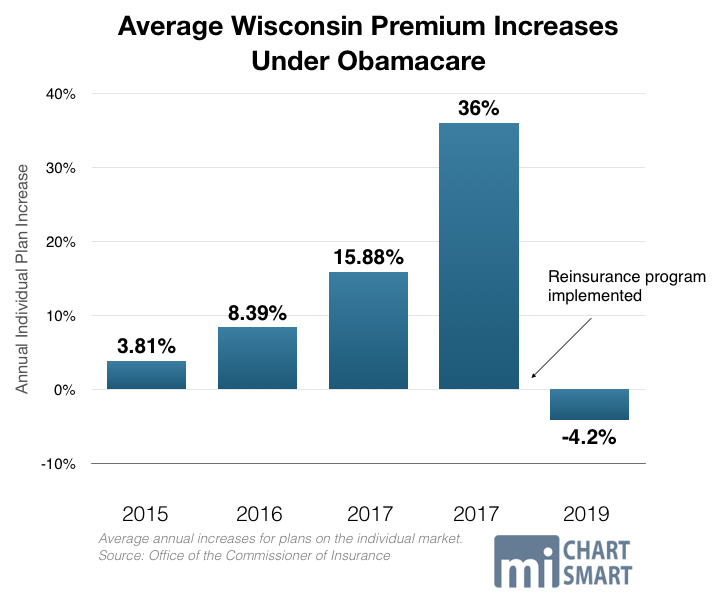
The reinsurance program was all but forced on Walker and Republican lawmakers in the wake of rapidly increasing premiums on the individual health insurance market. Headed into 2018, premiums were expected to spike by 36 percent, while 75,000 Wisconsinites were expected to lose coverage.
Only after the costly reinsurance tourniquet was applied to the state’s bleeding market did rates stabilize, with an average 4.2 percent weighted average premium decrease in 2019.
A signal from both sides of the aisle that Obamacare has failed to hold down health insurance rates or “bend the cost curve down,” continuing the costly reinsurance program to prop up Wisconsin’s individual health insurance market was met with little controversy or debate.
Medicaid expansion: two lines in the sand
Republicans held strong in refusing to expand Medicaid, which is certain to save taxpayers a fortune down the road by keeping a lid on enrollment in a notoriously expensive and inefficient program—one that gobbled up an extra $917 million just to keep pace with current enrollment. Even without expanding Medicaid, as in past budgets, the health services budget increase was still enormous.
Evers and his liberal allies campaigned on Medicaid expansion, building his budget on all of the “free” money that is supposed to come with the commitment. Evers threatened to veto any budget that did not include his proposal. His liberal allies egged him on, urging him to outright reject the Republican spending plan when it became clear that expansion was a no-go.
Republicans responded by drawing a hard line and unequivocally refusing to expand the welfare program. Expansion, Republicans argued, would be costly to the private insurance market, pushing up premiums and limiting access and affordability. It also would expand welfare at a time of unprecedented economic growth. Besides, Republican lawmakers argued their budget substantially increases health care and medical assistance funding without tying around Wisconsin’s neck the albatross of a debt-ridden federal government that has failed to keep funding promises to states.
Once JFC pulled out the Medicaid expansion, even Democrats acknowledged Evers’ budget would collapse under its own weight. “This budget is so tightly wound around that string of Medicaid expansion that if you pull that string the whole budget unravels,” state Sen. Jon Erpenbach (D-Middleton), told his Republican colleagues on the finance committee. Erpenbach called the Medicaid expansion the “motherlode of strings that you can pull.”
Republicans pulled it as one of their first actions on the budget, giving taxpayers and fiscal conservatives a big budget victory.
Medicaid expansion has been a costly proposition for states that have accepted it. Medicaid spending in Ohio, for example, skyrocketed 35 percent in four years – from $18.9 billion to $25.7 billion between fiscal year 2013 and 2017.
In Arizona, costly visits to the emergency room have jumped more than 300 percent and providers have shifted an additional $700 million in costs onto private plans after the Medicaid expansion.
In Rhode Island, Medicaid enrollment ballooned 63 percent and state spending on the program has increased 25 percent since expansion, forcing the state to consider a new payroll tax on employers.
These are just a few examples of why Republicans fought so hard to keep Medicaid expansion out of the budget. One more: the program has already ballooned in Wisconsin.
More than 1.1 million, or about 1 in 5, Wisconsinites are on Medicaid or related programs today. And while unemployment is at record lows, MA rolls have increased significantly over the years. In 2019, just 2.6 workers support every one MA recipient. In 1998, Wisconsin had 7.2 workers for every MA recipient.
Throughout the debate, Democrats alleged that the Medicaid expansion population of some 82,000 people has no access to affordable coverage and that only through a government-run program could they find affordable coverage; Republicans pointed out that that claim is untrue.
There are already affordable health insurance plans available on the private market, made affordable thanks to generous subsidies bankrolled by taxpayers via Obamacare. In fact, Nygren pointed to one private plan in Brown County costing as low as 18 cents per month with a $50 deductible. Other plans are available around the state for just a few dollars a month.
Ultimately, the GOP budget pumps more money into a broken system and opts against pursuing innovative new options in health care like direct primary care or dental therapy. A separate direct primary care bill is currently making its way through the Legislature, but unlike a previous version of the bill, this one omits a Medicaid direct primary care pilot program that could grow into huge taxpayer savings in the future.
Evers and the Legislature both made Medicaid expansion their line in the sand, but when the liberal governor saw all the money JFC dumped into MA, the governor seemingly made peace with the idea of letting go of his top campaign promise, at least for now. The Republican budget is merely a “down payment” on his “People’s Budget” vision of spending in the future, the governor said when he signed the budget into law.
In the end, he couldn’t say no to the large influx of cash the GOP budget offered up. That new money for DHS comes with little to no reform, which is a shame.
FULL ANALYSIS: WELFARE REFORM
Reforming government benefits programs has been a Wisconsin hallmark for decades, dating back to the administration of Gov. Tommy Thompson. More recently, Walker built on the welfare reforms of the 1990s with his own slate of policy changes. With a pair of vetoes, Evers tries to roll some of that legacy back.
The goal of welfare reform has always been to make sure recipients of taxpayer funded benefits knew the help wasn’t free — something would be expected of them in return. That’s an especially reasonable expectation today considering our state’s robust economy and roaring job market.
Evers’ 2019-21 initial budget proposal rolled back much of that progress and attempted to reinstate the notion of a “free lunch,” bankrolled by the hard working taxpayers of Wisconsin. Evers would have struck increased work requirements for Medicaid eligibility, nominal premiums and co-pays for Medicaid recipients, eliminated a requirement that Medicaid recipients be in compliance with child support orders, repealed all drug screening requirements, and eliminated work requirements for able-bodied adults with school-aged dependents (ages six to 18).
As we note below, only two of those proposals survived after Joint Finance made quick work of the “liberal wish list” budget, as legislative Republicans described it.
Medicaid expansion was certainly the crown jewel of Evers’ efforts to expand welfare in his budget proposal. While Democrats throughout the process painted the expansion as an effort to provide health care to a population they claimed had no access to affordable care, Republicans pushed back by accurately stating what the proposal did: expand welfare.
After Joint Finance Republicans voted to strip the Medicaid expansion from Evers’ budget, the entire proposal unraveled. “Gov. Evers’ budget started and ended with Medicaid. His budget ended the day Republicans took that expansion out,” said Sen. Erpenbach.
And so ended the single largest push for welfare expansion in the Evers budget. But with the stroke of his veto pen months later, the governor was able to strike a blow for big government when he vetoed two requirements for those seeking food stamps, also known as FoodShare.
Evers vetoed a work requirement for able-bodied adults with school-aged dependents who receive FoodShare. The requirement, part of Walker’s “Wisconsin Works For Everyone” welfare reform initiative, sought to expand on the success of work requirements for able-bodied adults without dependents.
He also removed drug testing for FoodShare recipients who are able-bodied adults with no dependents, a measure intended to help move people from drug addiction and government dependence into the workforce.
 Evers picks a strange time in Wisconsin history to reject reforms that put the onus on welfare recipients to at least try to find work. Our state’s unemployment rate stands at a near-record low of 3 percent, there are more than 100,000 jobs left unfilled, and employers everywhere are desperate for help.
Evers picks a strange time in Wisconsin history to reject reforms that put the onus on welfare recipients to at least try to find work. Our state’s unemployment rate stands at a near-record low of 3 percent, there are more than 100,000 jobs left unfilled, and employers everywhere are desperate for help.
And the Walker-era work requirements have been successful. The largest job training program in the state is the FoodShare Employment Training (FSET) program. FSET participants earned an average $13.64 per hour, nearly double the state minimum wage, according to the most recent data available.
Almost 31,000 FSET participants have gained employment since the state began tracking data in 2015.
Simply put, there is no excuse for an able-bodied adult who is capable of working to sit on the sidelines. Yet Evers’ budget makes it a whole lot easier to do just that.
“Because of his partial vetoes, he’s starving programs that incentivize work, undermining their implementation and skirting the law. We know people support drug testing and work requirements for welfare recipients and this budget ignores that fact,” said Assembly Speaker Robin Vos.
With his vetoes, Evers chips away at the notion that while taxpayers are generous, they expect at least a nominal effort in return for their hard-earned dollars.
And he does so at a time of unprecedented opportunity in the private sector in Wisconsin.
FULL ANALYSIS: UW SYSTEM
The UW System will see a $58 million increase in funding over the biennium, plus a continuation of the popular tuition freeze for in-state undergrads. The capital budget also includes $1 billion for building projects across the state.
Yet, following the JFC’s vote, UW System President Ray Cross said that he felt “kicked in the shins.” Not a bad swan song for the budget-busting spending at hand.
System administrators will have to first come back to JFC with a plan for how to spend $45 million of the new spending. Already baked into the budget are 2 percent raises in each year of the biennium for system employees.
But it wasn’t nearly enough for committee Democrats, who insisted the System needed more than twice that amount, proposing the $126.6 million spending increase that Evers offered in his massive $84.2 billion biennial budget plan. That dollar amount was an even bigger figure that the System had asked for, and included $50 million to backfill tuition revenue lost from the tuition freeze. Evers’ plan noted that the funds “may be used as the system sees fit, including to help struggling campuses or academic programs.”
That sounds a lot like the UW’s slush fund of hefty program revenue balances, a pot of money that legislators in the state’s CPA caucus discovered in 2013. The slush fund totaled over $1 billion, leading lawmakers to question why the UW continued raising tuition and asking for more funds when they had tucked away such sizable surplus balances.
The sentiment was summed up by then-Rep. Steve Nass (R-Whitewater), who stated that “more than 2/3 of this surplus was generated by unjustified tuition increases over the last three years. In other words, [then-UW President] President [Kevin] Reilly and the Board of Regents knowingly jacked-up tuition by 16.5 percent on Wisconsin families over three years even though the funds weren’t needed. These actions are nothing short of a betrayal of the public trust.”
The slush fund became the main impetus behind Walker’s tuition freeze and other program cuts. The system is now required to regularly report those figures and justify any large increases.
Since 2013, the System’s Program Revenue (PR) balances have increased. At the close of the 2018 fiscal year, total PR balances for the system stood at $1.3 billion, an 11.6 percent increase from 2014. However, a much larger proportion of the fund is restricted compared to 2013.
JFC Member Sen. Howard Marklein (R-Spring Green), a member of the Legislature’s CPA caucus, reflected on the 2013 discovery. 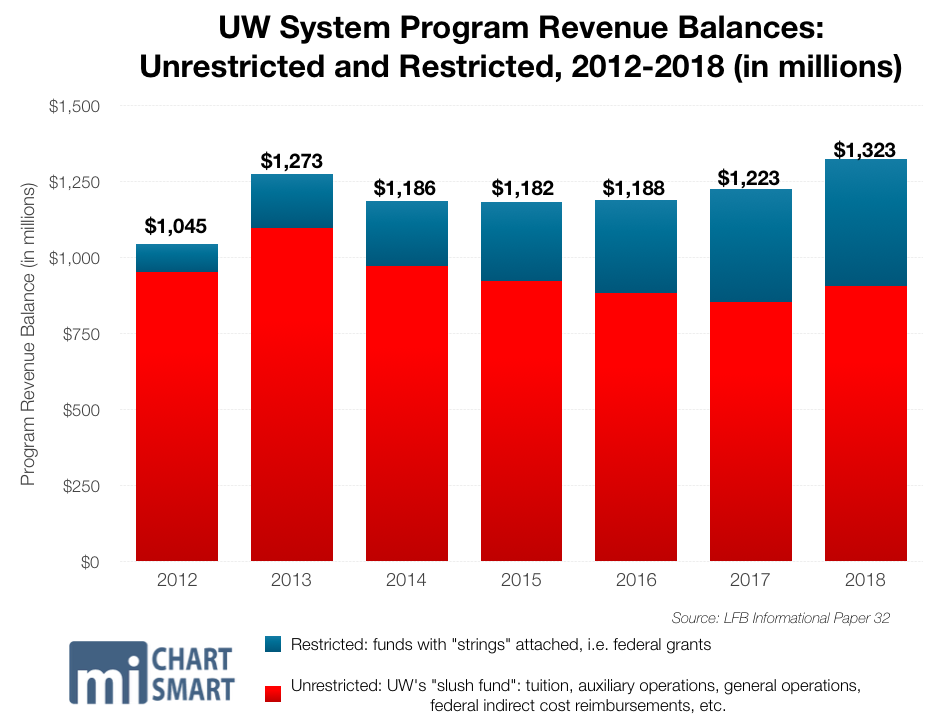
“At the time, the former UW System president was coming in talking about, ‘We’re broke.’ Meanwhile, looking at the audit reports and data, and there’s $1.2 billion sitting there,” Sen. Howard Marklein (R-Spring Green) recalled.
In its agency budget request, UW System didn’t ask for money to backfill tuition revenue, since that funding came in higher than expected this year. Documents from a UW Regents meeting show that for fiscal year 2018, the System will have $300.8 million in tuition balances. That’s 38 percent more than estimated in the 2017-18 operating budget, which predicted a $217.8 million balance.
During the budget vote, Committee Republicans also rejected a Dem omnibus package that included $45 million for “student success and attainment,” $10 million to hire more nursing program educators to deal with the state’s nursing shortage, and another $5 million for student advising.
As the nonpartisan Legislative Fiscal Bureau noted, the System could use the $45 million approved in the “block grant”-style appropriation to fund all or portions of Evers’ initiatives.
As for building projects, Republicans accepted 95 percent of Evers’ spending recommendations. The UW System will receive more than $1 billion in new spending for multi-million dollar projects across the state. The largest of these is a chemistry building at UW-Milwaukee, totaling $130 million. UW-Madison will see a veterinary medicine addition and renovation for $128 million, as well as a gymnasium replacement for $126 million. Another $176 million is spread system-wide for various utility improvements, facility renewal, and classroom renovations.
The new money comes as UW struggles with enrollment that has slowly declined since a peak in 2010. For fall 2018, north of 161,000 students are enrolled in UW System schools, including those who attend part-time. The four-year graduation rate for students who graduated in 2017 (the most recent figure available) was just 38.1 percent. As low as it is, that’s an improvement from students who graduated in 2011, when the four-year graduation rate was 28.7 percent. 
The low graduation rate may be related to significant issues with remedial education. As we wrote in the K-12 section above, thousands of new UW students are required to take remedial math and English every year, based on their performance on placement exams. Those come at the steep cost of full tuition but zero credit. Unfortunately, this budget does little to address that issue along with many others, which brings us to our next section…
FULL ANALYSIS: PROBLEMS AND MISSED OPPORTUNITIES
On issues from K-12 education, Medicaid, higher education, welfare reform to the capital budget, legislators enacted few reforms to go along with the billions more in new spending they provided. One possible reason for this missed opportunity: Evers has the most powerful line item veto in the country. The majority of the few reforms contained in this budget were predictably vetoed out by the governor.
Nevertheless, it’s crucial that both sides fight for their beliefs and make their positions known. Taxpayers deserve an honest and genuine debate about the direction of our great state. If the capital building program is clearly broken, what’s the harm in proposing a groundbreaking new strategy to fix it? Debating an idea in public is always better than agreeing to compromise behind closed doors.
Why didn’t we have a debate about the needed reform of MPS? Why didn’t we have a debate about the remedial education crisis and the fact that hundreds of Wisconsin high schools send thousands of students to the UW system unprepared to pass basic English and math tests? Why didn’t we have a debate about the need to empower parents to choose a school that’s right for their children?
Why didn’t we have a debate about the size, scope, and cost of state government?
There’s no way around it: this budget spends a lot of money, with virtually no strings attached. No attempt at reforming broken and inefficient government programs, and no attempt at eliminating antiquated or redundant government services. There are plenty of missed opportunities.

When Evers released his budget plan in late February, Republicans slammed the new governor for spending far more than the state could afford. Yet, in the end, Republicans backtracked on the fiscal austerity rhetoric and in many cases, ended up spending a lot more than what was necessary. With little attempt at attaching accountability measures to that spending, this budget simply pours more money into the big government abyss.
Evers had proposed increasing total government jobs by 701 full-time positions over the biennium. That would have brought the total number of all-funds state positions to 71,990.57 in 2020. JFC’s plan increased total positions by 482, up to 71,771.59 by 2020. That’s still a sizable increase. Plus, this budget gives all state employees 2 percent raises in each year of the biennium, and by constantly adding to state rolls, those types of increases will only be more expensive in the future.
In what can only be called a great disappointment for taxpayers, legislative Republicans tried to keep up with the liberals when it came to government largess. In some cases, they even outdid Evers’ original spending proposals. Prison guards, personal care workers, nursing homes, and Family Care direct care workers get considerably more funding than Evers requested.
Was all that new spending truly necessary? Will the money be spent wisely? Does government need 482 new positions? Being that the size and scope of government was hardly up for debate—only how much bigger to make it—we never really had that discussion. That’s a missed opportunity.
Taxpayers should also question the wisdom of pumping $655.4 million more GPR into the status quo educational system that fails too many children and is experiencing flat enrollment.
In this biennium, state support to K-12 schools will reach more than $14 billion, and DPI’s total budget spends north of $15.2 billion. Evers had proposed a $1.6 billion increase for the agency he headed until January, including more than $600 million to increase special education categorical aids. The final budget sends $330 million more into the equalization aid formula and $97 million more for special education categorical aids, along with a litany of other changes.
Lost in this debate is the fact that Wisconsin’s K-12 population has stayed relatively flat for many years. If we are not experiencing a huge influx of new elementary kids to educate, why do our schools need $600 million in new funds? And this $600 million increase is on top of the $600 million increase included in the 2017-2019 state budget.
Over a billion dollars in new funding to educate the same number of kids? Are we seeing any noticeable return on our increased investment? Again, lawmakers failed to have that debate this time around.
Also going virtually un-mentioned is the fact that more and more families are choosing other educational choices outside of the public education system. Choice, charter and home schooling are all growing in popularity. That’s no surprise given that statewide English proficiency sits at just 44 percent, and math proficiency at 41 percent. Yet this budget does nothing with school choice.
The K-12 educational system has continually failed many Wisconsin students, with thousands of new UW freshmen requiring remedial math or English. Those classes come with zero credit and the cost of full tuition, putting students behind before they even begin. Plus, many of these are students who were told they were doing well in school. More than half of Wisconsin’s five-star high schools sent more than 1,000 students who needed math remediation to UW.
That’s a problem for the UW institutions that need to offer remedial classes, it’s a problem for parents and students footing the bill, and it’s especially a problem for the high schools, who clearly are leaving a lot of work undone when they graduate oftentimes unprepared students. It’s yet another problem that was not discussed during the budget debate.
And when just 54 percent of our public education dollars reach the classroom, we must ask how hundreds of millions of dollars will improve student achievement? For their part, legislative Republicans acknowledged the system is broken. But they didn’t take the opportunity to couple a significant funding increase with required better outcomes and meaningful systematic reform.
The same can be said for the UW System and the millions more it received compared to the last budget. Like the K-12 system, enrollment at UW has slowly fallen over the years. With a strong economy and record-low unemployment, young people now know that the math has changed. It’s no longer a given that taking on tens of thousands of dollars in student debt will pay off in the long run, and enrollment trends reflect that.
Still, the capital budget approves over $1 billion in new funding for building projects across the UW System. Numerous campuses, like UW-Eau Claire and UW-Milwaukee, will get brand new buildings, and every campus will see millions more in improvement projects. After all these new buildings are completed, will the UW System finally stop insisting it is impoverished and in shambles?
Before the JFC vote on the capital budget, Nygren spoke passionately on how broken the system is. He lamented that taxpayers pay UW lobbyists that then lobby the state for more money. He also lambasted the fact that UW officials are the drivers of new projects, setting rates and budgets for new buildings, knowing that the Legislature usually just goes along with the plan.
Nygren is exactly right on this – but he and every other JFC Republican voted for the package. It’s refreshing to see legislators make strong arguments at the table. But it’d be more refreshing if they would actually pass the reforms they say they want.
The health care debate brought a similar tone. Republicans held strong in refusing to expand Medicaid, but they instead agreed to send $1.6 billion in all funds to DHS. Of that increase, $917 million (all funds) is the cost-to-continue price tag for the state’s massive Medical Assistance programs.
Rather than pursuing innovative reforms in taxpayer-provided health care programs like direct primary care, self-funded association health plans, limited duration health plans, and dental therapy, JFC pumped more money into the Medicaid system they acknowledge is broken.
Like so many other parts of the state budget, the new, incredibly generous funding for DHS came with little-to-no reforms attached. For taxpayers, this is frustrating and a huge missed opportunity to make Wisconsin a better place to live.
Too many politicians are content just throwing more money at these programs without addressing the fundamental causes of the problems and without making needed reforms to these programs.
FULL ANALYSIS: FISCAL POLICY – TAXES AND SPENDING OVERVIEW
As we’ve written above, this is a budget that knows how to spend. When Evers released his budget plan in late February, Republicans slammed the new governor for spending far more than the state could afford. Yet, in the end, Republicans backtracked on the fiscal austerity rhetoric and in many cases, ended up spending a lot more than what was necessary.
At times, the budget-writing process felt like a fiscal arms race, with Republicans pumping double, triple the amount of funding into this program or that agency. Don’t take our word for it. Some Republicans actually bragged about how much more spending they handed out. In the end, though, the party that controls the purse strings just couldn’t keep up with a liberal politician who has had the word ‘No’ surgically removed from his vocabulary — at least when it comes to grow-government funding requests.
At a grand total of $83.58 billion, the Republicans’ budget is undoubtedly hefty. But it still weighs in at about $2.6 billion less than Evers’ morbidly obese $86.2 billion biennial budget plan. That’s before Evers’ 78 vetoes, however – we’ll have final numbers once the nonpartisan LFB releases its comparative summary of the document.


For all of the spending, conservatives knew they needed to pack a powerful tax cut into the document in order to have enough Republican votes in the Senate to pass the budget to Evers’ desk. And they did.
Wisconsin has long been a high tax state. In the most recent Tax Foundation ranking of states with the highest and lowest state and local taxpayer burdens, Wisconsin checks in at sixth highest. When Gov. Scott Walker served as Wisconsin’s chief executive, Republicans cut taxes by more than $8 billion. That gives you an idea of how bad the Badger State’s taxing situation is.
The Republicans’ latest two-year budget continues the tax-cutting tradition. Conservatives came up with a $500 million-plus tax cut, bringing $91 in average income tax relief in the first year and $124 in the second. Those earning between $30,000 and $60,000 will see the biggest benefit.
This is achieved with cuts to the bottom two of four individual income tax rates. The second income tax bracket, currently at 5.84 percent, will fall to 4.93 percent in 2020. The bottom-most bracket will fall from 4.0 percent to 3.76 percent in 2020. Under the final package, the average tax filer will see more than $200 in tax relief in the next two years, with the bulk of the tax relief coming through income tax rate reductions. 
Evers proposed a bigger middle-income tax relief package, but he would have gotten there by raising taxes on manufacturers and retirees. Raising taxes on anyone or any group so the government can hand out a small “credit” to a select few is morally wrong. It is divisive politics at its worst. The only way Wisconsin will ever drop in the highest-taxed rankings is if we continue to cut tax rates for everyone, not create new credits for some.
Republicans spend a lot more in their budget, but they also continue a winning tradition of returning tax dollars to the hard-working people who pay the state’s bills.
Some tax increases were included in the package, including an excise tax of 5 cents per milliliter on vapor products used for e-cigarettes. Evers had proposed extending cigarette taxes to vaping products, which would have raised $36.4 million. Instead, Republicans raised $5.5 million in taxes on the increasingly popular products.
The major question for taxpayer lies in the future: will Republicans stand up to future tax increase ideas from Evers? With the 2019-21 budget behind us, it’s hard to say. They didn’t exactly make a strong stand for fiscal conservatism this time around. For all of our sakes, let’s hope the economy keeps booming so when the $1.4 billion structural deficit comes to roost in 2021, the Legislature isn’t tempted to increase taxes to fill the gap.

